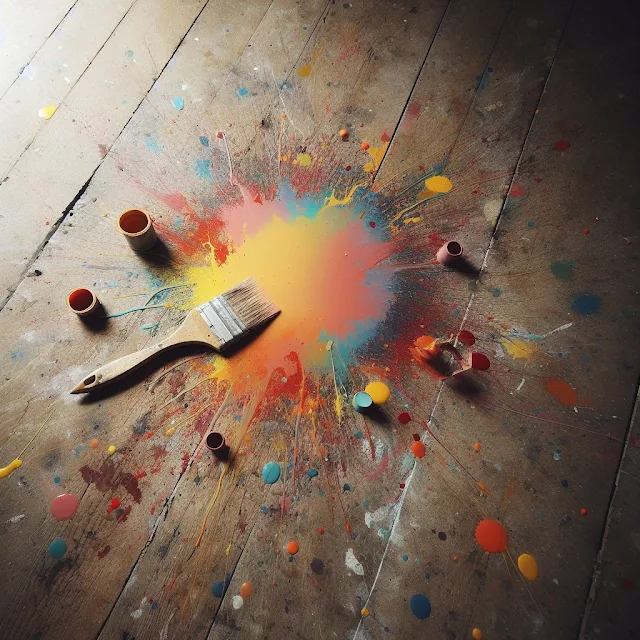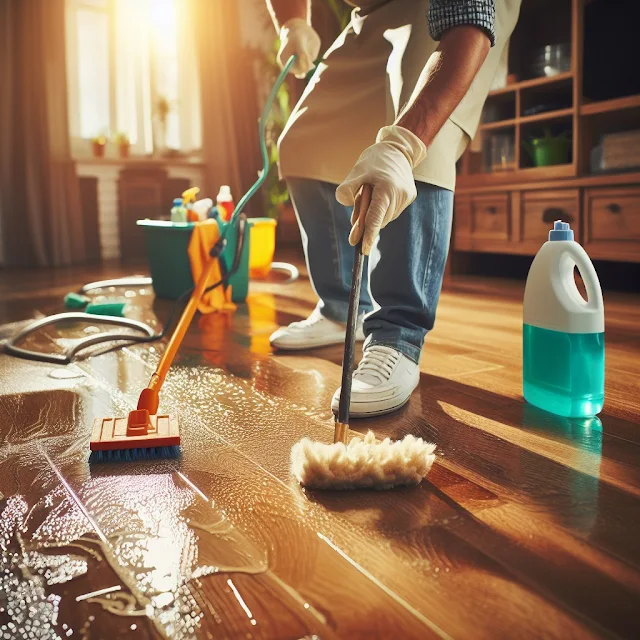Paint Splatter Attack? Don't Panic, Grab Your Spatula!
Hey there, fellow home warriors! We've all been there, right? You're in the throes of a DIY decorating masterpiece, brushstrokes flowing like a Jackson Pollock channeling your inner Picasso. Suddenly, BAM! A rogue splatter of paint leaps from your brush like a mischievous gremlin, landing smack dab on your beautiful wood floor.
Cue the dramatic music and internal screaming.
Your pristine floor, once a blank canvas for your interior design dreams, is now sporting a modern art installation you definitely didn't commission. Those tiny paint terrorists are mocking your clean-freak tendencies, daring you to engage in a battle for floor-tastic supremacy.
But fear not, brave DIYer! This is not the end. We're not about to let a few renegade paint drops dictate our home decor destiny. Today, we embark on a Wood Floor Rescue Mission, armed with an arsenal of household heroes and battle-tested tips. We'll vanquish those pesky splatters and reclaim the gleaming glory of your wood floors, faster than you can say "Bob Ross would be proud."
So grab your metaphorical spatula (or actual putty knife, we're not judging), put on your "I'm-about-to-clean-up-good" face, and let's get started. By the end of this epic saga, your floors will be splatter-free and you'll be doing a victory dance that would make even Elaine Benes jealous.
Ready? Let's do this!
How to Remove Paint Splatter from Wood Floors? Identifying the Paint Type Matters (Inform)
Ah, the enemy! Before we unleash our cleaning fury, a quick intel briefing is vital. Just like knowing your foe's weaknesses in a video game, understanding the paint type is key to swift and painless victory.
- Water-based paint: This playful puppy of the paint world is a pushover. Think latex, acrylic, your typical wall paint. It cleans up with the ease of a spilled juice box, usually just needing a warm soapy bath. Wipe it away, watch it disappear, and feel free to do a little victory fist pump. You earned it.
- Oil-based paint: Now, this guy's a bit more like a grumpy old bulldog. He's stubborn, he's messy, and he doesn't like to give up without a fight. Oil-based paints require a bit more elbow grease, some special tools like paint thinner (which is basically kryptonite to this oily villain), and maybe even a touch of patience. But don't worry, even this paint bully can be tamed. We'll show you how.
So, before you grab your cleaning weapons, take a peek at the paint can. Is it water-based, the friendly neighborhood Spidey? Or is it oil-based, the grumpy Thanos of the paint world? Knowing your enemy is half the battle, and in this case, it means a faster, smoother path to splatter-free bliss.
Now, let's gather our arsenal and get ready to rumble!
How to Remove Paint Splatter from Wood Floors? Mission Preparation (Action)
Alright, troops! Before we storm the splatter-infested battlefield, let's assemble our trusty cleaning companions. Think of it like arming yourself for a raid in your favorite video game - you wouldn't go in bare-handed, would you?
Here's what you'll need in your splatter-busting toolkit:
For both paint types
- Putty knife: Your trusty spatula for gently scraping away stubborn paint globs.
- Rags and cotton balls: Your soft, absorbent soldiers for wiping away the enemy.
- Warm water: A classic, versatile weapon that works wonders on fresh water-based splatters.
- Dish soap: This bubbly hero cuts through water-based paint like butter.
For oil-based paint (use with caution!)
- Paint thinner: The heavy artillery, best for stubborn oil-based splatters. Use sparingly and in a well-ventilated area, because this stuff is potent!
- Mineral spirits: Another option for oil-based paint, gentler than paint thinner but might require a bit more elbow grease.
Optional:
- Rubbing alcohol: A dab on a cotton ball can help loosen dried water-based paint.
- Sandpaper (fine-grit): For the truly stubborn splatters that just won't budge. Use with extreme caution and only on a small, inconspicuous area first to avoid damaging your floor finish.
- Touch-up stain: If you accidentally remove some wood stain along with the paint, this little magic marker can fix things right up.
Remember, always test any cleaner on an inconspicuous area of your floor first to make sure it doesn't damage the finish. Safety first, even in the heat of splatter battle!
Now that you're armed and ready, let's dive into the specific battle plans for each paint type. Water-based first, then we'll tackle the oil-based bad guys. Prepare for battle!
Operation: Splatter Elimination (Step-by-Step Guide)
Alright, troops! We've identified the enemy, gathered our arsenal, and now it's time to take action! Let's break down the battle plan for each paint type, one splatter at a time.
Water-based Paint
- Fresh Splatter
- Dip your rag in warm soapy water. Think of it as a soapy shield against the paint's watery advances.
- Gently wipe the splatter in the direction of the wood grain. Don't scrub, or you might spread the paint further. Be patient and let the soapy water do its magic.
- Rinse your rag frequently. You don't want to be dragging dirty paint around your floor.
- Repeat steps 1-3 until the splatter is gone. Then admire your handiwork and pat yourself on the back – you just conquered a paint gremlin with the power of soap!
- Dried Splatter
- Dab a cotton ball in rubbing alcohol. It's like giving the dried paint a little wake-up call.
- Place the cotton ball on the splatter and let it sit for a few minutes. Give the alcohol time to loosen its grip.
- Gently wipe the softened paint away with a clean rag in the direction of the wood grain.
- Repeat steps 1-3 if needed. Sometimes stubborn dried paint requires a second round. But don't worry, you've got this!
Oil-based Paint
Prepare for a slightly tougher battle here, soldier. But remember, even Thanos eventually met his match.
- Apply a small amount of paint thinner or mineral spirits to a clean rag. Just a dab will do, this stuff is potent.
- Let the paint thinner sit on the splatter for a few minutes. It needs time to penetrate and break down the tough oil-based paint.
- Gently scrape the softened paint away with your trusty putty knife. Be careful not to scratch your floor.
- Wipe the area clean with a fresh rag.
- Repeat steps 1-4 if necessary. Some stubborn splatters might need a second dose of paint thinner.
- If you accidentally removed some wood stain along with the paint, don't fret! Apply a touch-up stain to the affected area using a fine-tipped brush. You'll be amazed at how easily it blends in.
Remember, patience is key with oil-based paint. Don't scrub or scrape too hard, or you could damage your floor. Let the paint thinner do its work, and you'll be rewarded with a splatter-free victory dance.
And there you have it! A step-by-step guide to vanquishing those pesky paint splatters, no matter their watery or oily nature. Now go forth and conquer, brave floor warrior! Your wood floors await their gleaming, splatter-free destiny.
Final Thoughts and Preventative Measures (Wrap-Up)
Woohoo! Mission accomplished! You've battled the paint splatters, and emerged victorious, and your wood floors are shining like a freshly polished trophy. Time to crank up the victory music and do a happy jig worthy of Elaine Benes herself. You deserve it!
But before you get too lost in your dance moves, let's take a moment to reflect and prevent future paint-related mishaps. Remember, an ounce of prevention is worth a pound of...well, paint splatter removal.
Here are a few tips to keep those splatters at bay:
- Deploy drop cloths like a ninja. Cover your floors with plastic sheeting before you even crack open the paint can. It's like building a protective moat around your precious wood.
- Befriend painter's tape. This sticky friend is your line of defense against rogue brushstrokes. Tape off baseboards, trim, and any other areas you don't want to accidentally paint.
- Master the art of the controlled brush. Don't let your brush become a paint-flinging madman! Use smooth, even strokes and avoid overloading it with paint.
- Clean up spills immediately. Fresh paint is easier to deal with than dried splatters, so don't let those little accidents linger.
By incorporating these simple habits into your painting routine, you can significantly reduce the risk of future splatter attacks. Remember, a little prevention goes a long way toward maintaining those beautiful, splatter-free floors you've worked so hard for.
Now, go forth and paint with confidence, knowing that you're armed with the knowledge and skills to tackle any splatter that dares to cross your path. And if you ever find yourself in another paint-related pickle, don't hesitate to call on your trusty cleaning companion – this blog post!
Happy painting, and happy splatter-free floors!
Fun Facts and Splatter-tastic Extras!
While you're basking in the glory of your splatter-free floors, why not add a sprinkle of fun facts to your post-battle celebration?
- Did you know wood floors are like living things? They breathe, expanding and contracting with changes in humidity. This means they can sometimes develop tiny gaps between planks, which is why it's important to maintain the proper humidity level in your home (ideally around 30-50%).
- Speaking of history, some wood floors have seen some serious things! The oldest known wooden floor is over 5,200 years old and was found in a Neolithic village in Switzerland. Imagine the stories those planks could tell!
- And who knew wood floors could be so artistic? There's a whole genre called "parquetry" dedicated to creating intricate patterns and designs using different types of wood. Now that's some serious floor game!
- But let's be honest, sometimes paint splatters happen. And when they do, it can be pretty darn funny! Just check out these online communities dedicated to sharing splatter fails. You'll laugh, you'll cringe, and you'll definitely feel a little better about your own paint-related mishaps.
- Finally, remember, that even the most seasoned DIYers have their splatter moments. Don't beat yourself up if you end up with a few rogue paint drops on your floor. Just grab this handy blog post, follow the steps, and channel your inner splatter-busting superhero!
So there you have it, folks! A splatter-tastic mix of facts, humor, and helpful tips to keep your wood floors looking their best. Now go forth and conquer, paint with confidence, and most importantly, have fun!
P.S. Did you know you can actually use leftover paint to create cool artwork? Stay tuned for a future blog post where we'll explore the creative side of paint...splatters and all!

